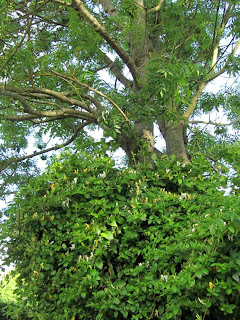 |
| Approaching rain sending seagulls inland |
The wet theme appears to be continuing through November: there's drama in the skies but little chance to enjoy the trees' autumn colour before their leaves are whipped away by an unforgiving wind.
Since most of our gardening jobs are temporarily on hold, I thought I'd use this blog to highlight some of the hardy "thugs" of our local plantworld which you might think twice before accepting into your little corner of paradise. Many of these appear innocent and beguiling in their infancy, but we've learned from bitter experience - both in our garden and in others - that they can turn into horrors after just a couple of years.
 |
| A wild and woolly Lonicera periclymenum |
It probably took a bit longer than that to grow this honeysuckle up a pair of ash trees in order to screen our garden from the back lane. To start with we welcomed its fragrant blooms and the fact that it remained fairly evergreen, providing a good nest site for our tuneful blackbirds...
But this year we decided it was screening too much light from the garden and had scrambled up too high for pruning; so out came the shears and I held the ladder steady while Christina hacked it all down. We must have taken three trailer-loads to the dump, uncovering in the process several deep welts made by honeysuckle stems twining around the trunk of a young ash tree.
 |
| Cruelty to trees |
I doubt if this kind of damage would happen so quickly in the UK but it does demonstrate how you have to take into account the added vigour of all climbers grown over here. Honeysuckle certainly makes a lovely hedge - but can easily bring down the wire fence that it's grown on. Be warned!
Whereas one can tolerate a certain amount of ivy in an English garden, here it not only degrades wood and stonework but also seeds itself liberally in the most awkward places and is difficult to dislodge from under walls and hedges. I'm sure it's been the ruination of many a good tree and we try to operate a policy of zero-tolerance.
 |
| Wisteria sinensis looking deceptively innocent |
Even a heavy-gauge wire fence is no match for those strong, twining stems.
 |
| Ouch, that hurts! |
I'm afraid we took drastic action with the one in this photo, chopping into the main trunk so that hopefully it can be grown as a standard tree, which can still produce lots of lovely trailing blooms without wrecking the fence.
Another climber which is a popular adornment to gateposts and railings is the exotic trumpet vine or Campsis grandiflora, known as 'bignon' in French. It's popular with the British and does look wonderfully tropical but it also throws up no end of shoots which can travel all over the garden and appear uninvited in the middle of lawns and flowerbeds.
 |
| Valerian (Centranthus rubra) |
There's even more temptation to grow architectural specimens such as the larger euphorbias and the much-admired Acanthus mollis or Bear's Breeches.
 |
| Euphorbia characias wulfenii, with smaller cousin myrsinites |
I've mentioned Acanthus in a previous post and it's definitely something to be kept separate from the rest of the garden; when chopped down, it has a tendency to push up elsewhere and those fleshy roots are very hard to eradicate.
The large Euphorbia characias is fine for a couple of years and looks splendid in early spring when there isn't much else around; but clumps soon get overly big and woody and those sap-leaking stems are a pig to dispose of, making a mess of your secateurs and possibly giving you a skin rash into the bargain. Smaller versions, like Euphorbia myrsinites, are useful ground cover and still provide that striking acid green to liven up your border.
 |
| Yucca recurvifolia |

These leaves are attractive when young but pretty lethal even with gardening gloves. The problem arises as the shrub matures and spreads, becoming ever more unmanageable with its sharp spikes until you eventually have to take a chainsaw and cut through the base; even then, fresh shoots continue to sprout and may take years to eradicate. A mega-thug!
But I don't want to sound as if you'll be severely limited in what you can safely grow because rest-assured there are nearly always alternatives and this is what makes gardening so interesting. You may not find them at your local garden centre but perusing a good seed catalogue, like Chiltern's which I've mentioned before, will often describe more garden-friendly varieties of plants, including those which have been accorded the RHS Award of Garden Merit. If you don't want to grow something from seed, then at least you'll be armed with the name of a cultivar to search for at a plant fair - French horticulturalists are usually well-informed and all too happy to help!
 |
| Spindleberries in the wild |
Plant breeders have cultivated many interesting varieties of Euonymus, some with evergreen and variegated leaves, others with yellow or red-tinted leaves which fall in autumn. I'd recommend having at least one Spindleberry in your garden, either as a specimen shrub or as part of a mixed hedge.
 |
| Our valley finally parading its autumn colours! |







